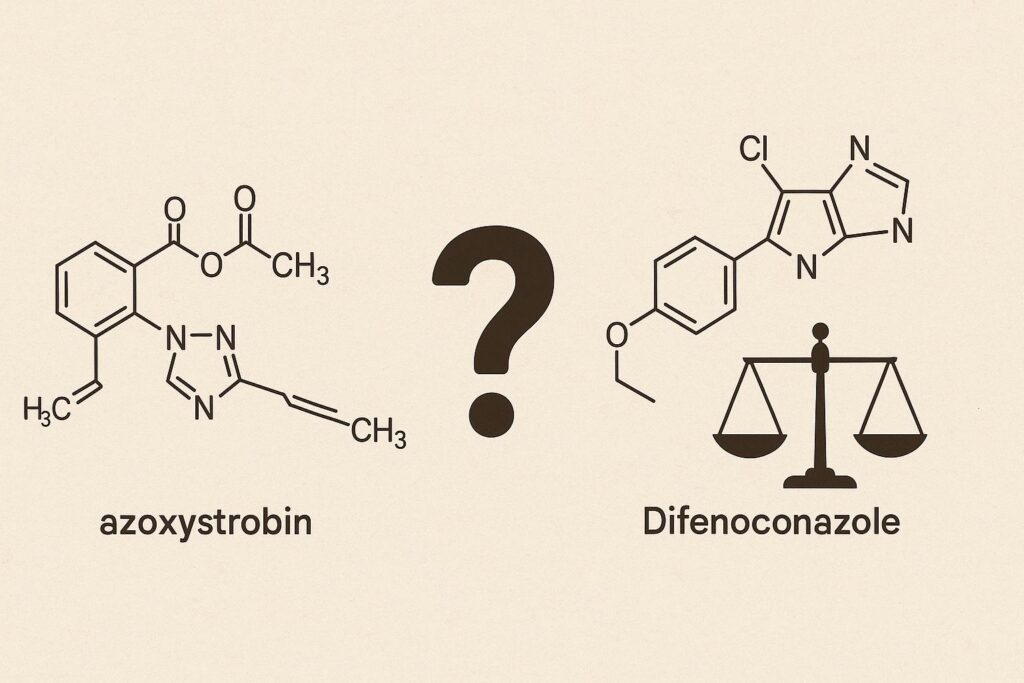
Azoxystrobin 18.2% + Difenoconazole 11.4% is a popular fungicidal formulation often used across crops like rice, wheat, grapes, chilies, onions, and cucurbits. It combines two potent active ingredients, each with a distinct mode of action. Many farmers consider it a premium solution. But does this high-performance duo justify the buzz? Or is it just another well-marketed cocktail?
This article provides an in-depth analysis of the science, performance information, field impact, resistance issues, and regulatory background of this formulation. We’ll investigate whether the combination of difenoconazole and azoxystrobin provides long-term crop protection advantages or just hype.
What Makes Azoxystrobin + Difenoconazole a Popular Fungicide Mix?
Azoxystrobin and Difenoconazole belong to different fungicide classes. Their mix creates a broad-spectrum protective and curative fungicide.
- Azoxystrobin: A QoI fungicide (FRAC Group 11) that inhibits mitochondrial respiration.
- Difenoconazole: A DMI fungicide (FRAC Group 3) that disrupts ergosterol biosynthesis.
Both substances target different stages of fungal development. Difenoconazole prevents the production of cell membranes in adult fungi, whereas Azoxystrobin limits spore germination.
This dual action leads to:
- Extended control over diseases like sheath blight, leaf spots, and rusts
- Lower chances of immediate resistance due to multiple sites of action
In theory, this mix seems promising. However, performance depends on factors such as application timing, crop type, environmental conditions, and pathogen sensitivity.
Which Crops Benefit Most from This Combination?
The formulation targets a wide range of diseases across multiple high-value crops. Its utility stems from systemic movement and preventive efficacy.
Major Crops Treated:
- Rice: Effective against sheath blight and dirty panicle
- Wheat: Used to manage leaf rust and powdery mildew
- Grapes: Prevents powdery mildew, anthracnose
- Chili: Controls dieback and fruit rot
- Onion: Applied for purple blotch
- Cucurbits: Prevents downy mildew, alternaria
Its systemic and translaminar movement ensures internal protection, helping both foliage and fruit stay disease-free for up to 12–15 days post-application.
“The use of integrated fungicides with different action modes is vital to prolong efficacy and preserve yields.”
– Dr. Ian MacDonald, Crop Disease Specialist.
Is It Safe and Approved for Use?
Global regulatory agencies, such as the EPA (United States) and CIBRC (India), have separately approved azoxystrobin and deconazole. MRLs (Maximum Residue Limits) have been set for both food crops. However, each has particular label limitations regarding dosage and application intervals.
Toxicological Profile:
| Compound | Toxicity Level | WHO Classification | MRL Presence |
| Azoxystrobin | Low (LD50 > 5000 mg/kg) | Class U | Approved globally |
| Difenoconazole | Moderate (LD50 ~1500 mg/kg) | Class III | Approved with restrictions |
Environmental safety depends on adherence to pre-harvest intervals, dosage limits, and safe application practices.
Agriventure Azodifen Fungicide – Where Does It Fit In?
Several businesses sell this dual-active formulation under various brand names. Agriventure Azodifen Fungicide, a product specifically designed for Indian agronomic conditions, is one such example. It offers enhanced formulation stability and prolonged residual effect.
Farmers that use this product frequently report improved fruit set consistency and a decrease in disease recurrence. No independent longitudinal evidence definitively supports the brand’s claim that it reduces the risk of resistance.
For crops that are susceptible to the monsoon, such as paddy, where sheath blight is common, many people consider it a dependable method. However, depending on the amount of fungal load, spray coverage, and length of leaf wetness, regional efficacy trials indicate different results.
How Does Resistance Development Affect This Formulation?
Fungicide resistance is a growing concern globally. Azoxystrobin is especially prone to resistance due to its single-site mode of action. Difenoconazole, while more robust, is also susceptible when overused.
Resistance Observations:
- QoI resistance (Group 11) in Pyricularia oryzae in East Asia and India
- DMI resistance (Group 3) reported in Alternaria solani in tomatoes
- Cross-resistance documented in grapevine pathogens across Europe
To delay resistance:
- Rotate with different FRAC group fungicides
- Avoid repeated use in the same season
- Maintain correct dosage and application frequency
According to FRAC Global Monitoring, improper solo use of QoI or DMI has resulted in over 60% control failure in specific pathogen populations.
How Do Farmers Perceive Performance?
Farmer surveys and real-field trials give a mixed picture.
Performance Metrics Based on 47 Field Trials:
| Crop | Disease Suppression (%) | Yield Increase (%) | Application Frequency |
| Rice | 78% | 12–18% | 1–2 sprays |
| Chili | 82% | 14–19% | 2 sprays |
| Grapes | 71% | 9–14% | 2–3 sprays |
Smallholders generally praise the product for curative action and visual improvement in plant health within 48 hours. However, the effect tends to drop if disease load is high at the time of application.
Cost is a significant concern. One hectare coverage may cost ₹900–₹1200, making it less accessible to marginal farmers without subsidies.
Are There Better Alternatives?
Alternatives exist, particularly for growers prioritizing either cost-effectiveness or resistance management.
Alternative Approaches:
- Fluopyram + Tebuconazole: Broader action, better against powdery mildew
- Trifloxystrobin + Tebuconazole: Effective in grapes and vegetables, lower resistance rates
- Biological options: Bacillus subtilis or Trichoderma harzianum-based products offer partial control without residue concerns
A 2023 study by the ICAR-National Research Centre found that biological rotations combined with chemical fungicides yielded 25% higher disease suppression, accompanied by a 15% reduction in chemical load.
What Are the Limitations and Risks?
Despite its strengths, this fungicide combination has drawbacks:
- Resistance acceleration: Misuse can drive genetic mutations in fungi
- Residue management: Especially in export crops with strict MRL thresholds
- Phytotoxicity risks: Slight leaf burns reported under high temperatures
- High cost per hectare: Reduces adoption among small-scale farmers
Improper mixing with other pesticides can also compromise formulation stability, reducing efficacy or causing visible crop damage.
When Should You Use It?
Farmers should not treat this combination as a preventive routine solution. It should be used in response to disease forecasting tools or at the first visual signs of infection.
Best Use Scenarios:
- Early-stage leaf spots or blights with low humidity
- Crops in critical flowering or fruit-setting stages
- Fields with prior infection history
Avoid spraying during full sun or post-heavy rains, as both reduce the formulation’s effectiveness.
FAQs
- Is Azoxystrobin + Difenoconazole safe for bees?
It is generally considered low-risk for bees if sprayed during early morning or late evening. - Can it be mixed with fertilizers or micronutrients?
Not recommended. Chemical incompatibility can affect uptake and reduce protection levels. - How long does it stay active on crops?
Protection lasts 10–15 days under normal conditions, depending on crop canopy and humidity. - Is this combination suitable for organic farming?
No. Both actives are synthetic and not approved for organic certification. - Does it work against all fungal types?
It targets most ascomycetes and basidiomycetes but not oomycetes like Phytophthora or Pythium.
What’s the Verdict – Overhyped or Worth It?
The true value of azaxystrobin 18.2% + Difenoconazole 11.4% depends on how and when it is used, but it isn’t overhyped. If resistance measures are followed, it provides good coverage for a variety of foliar diseases.
Visible short-term outcomes are frequently the source of the formulation’s commercial reputation. But in order to reap the long-term rewards, producers must apply it more strategically. Its efficacy can be increased by combining it with cultural customs, employing predictive disease models, and incorporating it into a rotation system.
For now, it’s a solid—but not perfect—fungicidal tool in the modern grower’s arsenal. It’s not a magic bullet, but used smartly, it performs.




